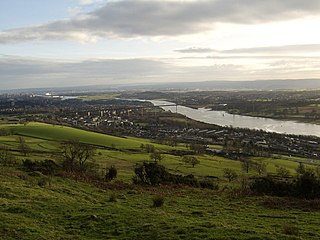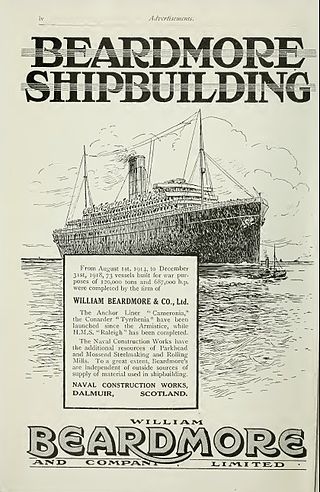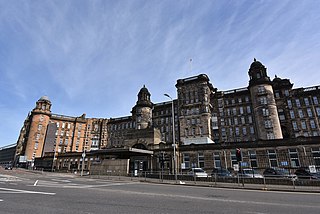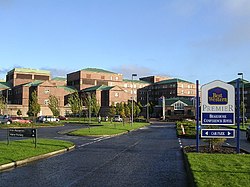
Clydebank is a town in West Dunbartonshire, Scotland. Situated on the north bank of the River Clyde, it borders the village of Old Kilpatrick to the west, and the Yoker and Drumchapel areas of the adjacent City of Glasgow immediately to the east. Depending on the definition of the town's boundaries, the suburban areas of Duntocher, Faifley and Hardgate either surround Clydebank to the north, or are its northern outskirts, with the Kilpatrick Hills beyond.

The SEC Centre is Scotland's largest exhibition centre, located in Glasgow, Scotland. It is one of the three main venues within the Scottish Event Campus.

Auchenshuggle is an area of Glasgow in Scotland, to the south of Tollcross.

William Beardmore and Company was a British engineering and shipbuilding conglomerate based in Glasgow and the surrounding Clydeside area. It was active from 1886 to the mid-1930s and at its peak employed about 40,000 people. It was founded and owned by William Beardmore, later Lord Invernairn, after whom the Beardmore Glacier was named.
ROF Dalmuir was an Engineering Royal Ordnance Factory owned by the UK government during World War II. The factory manufactured medium-calibre guns, particularly anti-aircraft guns. After the war, the factory manufactured armoured fighting vehicles.

Clydebank railway station is a railway station serving the town of Clydebank in West Dunbartonshire, Scotland. It is located on the Argyle Line and the North Clyde Line. Passenger services are operated by ScotRail.

Singer railway station is a two-platformed staffed station serving Clydebank town centre, West Dunbartonshire, Scotland. It is located on the Argyle Line and North Clyde Line between Drumry and Dalmuir, 9 miles 5 chains (14.6 km) from Glasgow Queen Street, measured via Maryhill. All passenger services are provided by ScotRail.

The Glasgow Royal Infirmary (GRI) is a large teaching hospital. With a capacity of around 1,000 beds, the hospital campus covers an area of around 8 hectares, and straddles the Townhead and Dennistoun districts on the north-eastern fringe of the city centre of Glasgow, Scotland. It is managed by NHS Greater Glasgow and Clyde. It was originally opened in 1794, with the present main building dating from 1914.

Dalmuir is an area nine miles northwest of Glasgow, Scotland, on the western side of Clydebank, and part of West Dunbartonshire Council Area. The name is a lowland Scots derivation of the Gaelic meaning Big Field. The area was originally two separate villages with Dalmuir Shore joining with Clydebank in 1886 and Dalmuir Village in 1906, during a period of rapid industrialization and expansion. Dalmuir is bounded by the village of Old Kilpatrick to the west, the Mountblow and Parkhall housing schemes to the north, and the Clydebank town centre area to the east. To the south is the River Clyde.
The Glasgow, Yoker and Clydebank Railway was a railway company that opened in 1882, giving a rail connection to shipyards and other industry that developed in what became Clydebank. At first it was a purely local line, connecting only at Stobcross with the North British Railway, but as industry developed in the area it served it became increasingly important.

NHS Scotland, sometimes styled NHSScotland, is the publicly–funded healthcare system in Scotland and one of the four systems that make up the National Health Service in the United Kingdom. It operates 14 territorial NHS boards across Scotland, supported by seven special non-geographic health boards, and Public Health Scotland.

William Beardmore, 1st Baron Invernairn, DL, known as Sir William Beardmore, Bt, between 1914 and 1921, was a British industrialist, founding the eponymous William Beardmore and Company.

Stobhill Hospital is located in Springburn in the north of Glasgow, Scotland. It serves the population of North Glasgow and part of East Dunbartonshire. It is managed by NHS Greater Glasgow and Clyde.

Inverclyde Royal Hospital is a district general hospital in Greenock which serves a population area of 125,000 consisting of Inverclyde, Largs, Isle of Bute and Cowal Peninsula. Inverclyde Royal Hospital is one of three main hospitals in the South Clyde area, alongside Vale of Leven Hospital in Alexandria and Royal Alexandra Hospital in Paisley and is managed by NHS Greater Glasgow and Clyde.

University College Hospital at Westmoreland Street, named The Heart Hospital until refurbished and renamed in 2015, was a specialist cardiac hospital located in London, United Kingdom until 2015. It is part of the University College London Hospitals NHS Foundation Trust and is closely associated with University College London (UCL). After the 2015 refurbishment, the hospital now provides thoracic surgery and urology services.
Finlay Hart was a Scottish communist politician.

Catherine Jane CalderwoodFRCOG FRCPE is Northern-Irish born Scottish consultant obstetrician and gynaecologist, who has served as the National Clinical Director for Sustainable Delivery at the Golden Jubilee University National Hospital since 2021. She previously served as the Chief Medical Officer for Scotland from 2015 to 2020, having advised the Scottish Government's initial response to the COVID-19 pandemic in Scotland.

The NHS Centre for Integrative Care, formerly the Glasgow Homeopathic Hospital, is an NHS treatment centre specialising in holistic treatments, including the use of homeopathy, on the Gartnavel Hospital campus in Glasgow, Scotland. It is managed by NHS Greater Glasgow and Clyde.
















